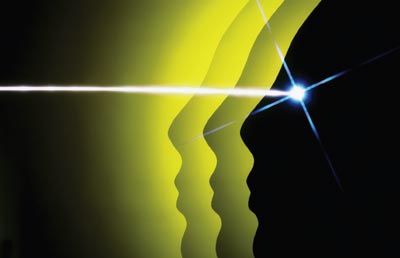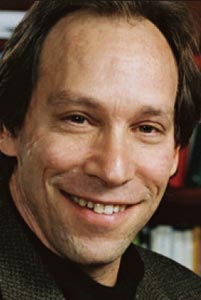Even with the many observations planned over the next decade, there is a real chance that we will never understand the true nature of dark energy, argues Lawrence M Krauss

The discovery 10 years ago that the expansion of the universe is accelerating, which implies that most of the universe is made up of a gravitationally repulsive substance called dark energy, was one of the most profound observations in cosmology. Several of us theorists had actually argued a few years earlier that something like dark energy must exist — the reason being that such a substance could iron out inconsistencies in, for example, measurements of Big Bang nucleosynthesis and of the age of the universe. But the direct observation of cosmic acceleration via measurements of distant supernovae demonstrated to the entire community that our understanding of cosmic evolution required a major overhaul.
We have no explanation whatsoever for the measured density of dark energy based on our fundamental theories of particle physics. Since the initial conditions of the universe were presumably determined by such fundamental laws, understanding what dark energy is will undoubtedly force us to question our knowledge of the earliest moments of the Big Bang. This is why it is so exciting to try and solve the mystery of both the origin and nature of this exotic form of energy that seems to permeate empty space.
The problem, however, is that it is quite likely that future observations — limited by both experimental uncertainties and the lack of any theoretical guidance on what to look for — will shed little new light on these all-important questions. Instead, we may require new theoretical ideas to resolve the nature of dark energy, and these are often harder to come by than new observations.
Preposterous prediction
Although we do not have a theory that allows us to predict the observed value of the density of dark energy, we do have a likely candidate for its origin: the cosmological constant. Proposed by Einstein in 1917 as an extra term in his equations of general relativity to make possible a static and eternal universe (which was the prevailing wisdom at the time), the cosmological constant is a form of “antigravity” that permeates all space.
Since the 1960s, however, such a constant term has had an alternative theoretical underpinning. Quantum mechanics, combined with relativity, implies that empty space is full of a wild brew of virtual particles that pop in and out of existence so quickly that we cannot directly detect them. Nevertheless, these particles leave a measurable imprint on everything from the spacing between atomic energy levels to the Casimir force that draws together metal plates brought very close to one another.
One might expect these virtual particles to contribute an energy to empty space, which would result in an identical term to Einstein’s original cosmological constant that would lead to universal repulsion and hence an accelerating universe. This form of “vacuum energy” is gravitationally repulsive because it possesses a negative pressure that is equal and opposite in magnitude to its energy density. In other words, the ratio of the pressure to the energy density — called the “equation of state” parameter, w — has a value of –1.
Such a fundamental, microscopic explanation for dark energy is just what cosmologists are looking for. But there is one huge catch: when we attempt to estimate the magnitude of the vacuum energy based on our current understanding of elementary particle physics, we get a value that is 120 orders of magnitude larger than the measured value! This means that if dark energy corresponds to a cosmological constant that arises from a non-zero vacuum energy, then there is something fundamentally wrong with our knowledge of particle physics. On the other hand, the source of dark energy may only mimic a cosmological constant at the present time, and may actually be something more complicated that varies as a function of time. Indeed, it could be that such a dark-energy source disappears completely at some time in the future, which may imply that nature’s fundamental vacuum energy is precisely zero. We could then understand such a value as being due, perhaps, to some new symmetries of nature that exactly cancelled out the contributions of all the virtual particles.
But therein lies the rub. The only way we can determine from observations that dark energy is not a cosmological constant is to somehow measure its equation of state parameter, w, and find that it is not, or was not, equal to –1. If the measured value is indistinguishable from –1 within experimental uncertainties, then we have not learned anything at all because dark energy could either be a cosmological constant or something else less (or more) exotic that behaved very much like it. The observational challenges in distinguishing between these scenarios are daunting in the extreme.
The observational challenge
Existing data show that –1.2 < w < –0.8, which means that we know w is very close to the cosmological-constant value of –1. But since we have no theory whatsoever to guide us if w turns out not to equal –1, either today or earlier in cosmic history, we have to allow for the possibility that w varies arbitrarily with time. When this theoretical uncertainty is combined with the likely systematic uncertainty of observations — for example due to difficulties in determining the absolute brightness of supernovae — it will be very hard to tell whether the equation of state of dark energy actually deviated from –1 at any time in the past.
Earlier this year I, along with Dragan Huterer at the University of Chicago and Kate Jones-Smith of Case Western Reserve University, calculated that even if 3000 supernova observations were made with a measurement accuracy slightly better than anything that has been possible thus far, then the constraints on the measured value might improve by at most a factor of 2 once the theoretical uncertainty in w is incorporated. In other words, –1.1 < w < –0.9 (New J. Phys. 9 141).
But let us say, for the sake of argument, that the true value of the equation of state parameter is w = –0.96. Then, even if we are able to improve the existing uncertainty in w by a factor of 10 using a variety of proposed techniques beyond simply measuring distant supernovae, a value of w = –1 will only be two standard deviations away from the best fit value (which may not even correspond to w = –0.96). Unfortunately, such confidence intervals occur routinely in physics and, while suggestive, are not sufficient to claim a discovery.
This does not mean that we should give up on efforts to measure w. It just means that observers will have to work very hard to reduce systematic uncertainties in, for example, supernova measurements to below current levels. And even if experimentalists manage such a feat, we have to live with the distinct possibility that making significant progress — i.e. answering the question of whether dark energy is a cosmological constant or something else — may be beyond our experimental reach.
A very special time
If we cannot answer this question, then our ability to constrain models in fundamental particle physics will be limited because we will not know if dark energy is due to vacuum energy or something else. But such ignorance will also make it difficult to predict the longterm future of the universe. Indeed, if dark energy really is a cosmological constant, then scientists 100 billion years or so from now will lose all evidence that we live in an expanding universe dominated by dark energy. This is because by then the cosmic acceleration will have caused distant galaxies and supernovae to recede at velocities greater than the speed of light, thereby taking these markers of cosmic dynamics forever out of view.
It therefore seems that we are living in a very special time, namely the only time in the history of the universe that we might actually be able to infer the existence of dark energy itself. Perhaps, therefore, we should not feel too bad if observations in the coming decades do not allow us to untangle the mystery of the nature and origin of dark energy. After all, it is often the mysteries themselves that keep scientists going, energizing theorists to continue to speculate about the ultimate nature of reality and motivating observers to seek out new tools to probe it.




